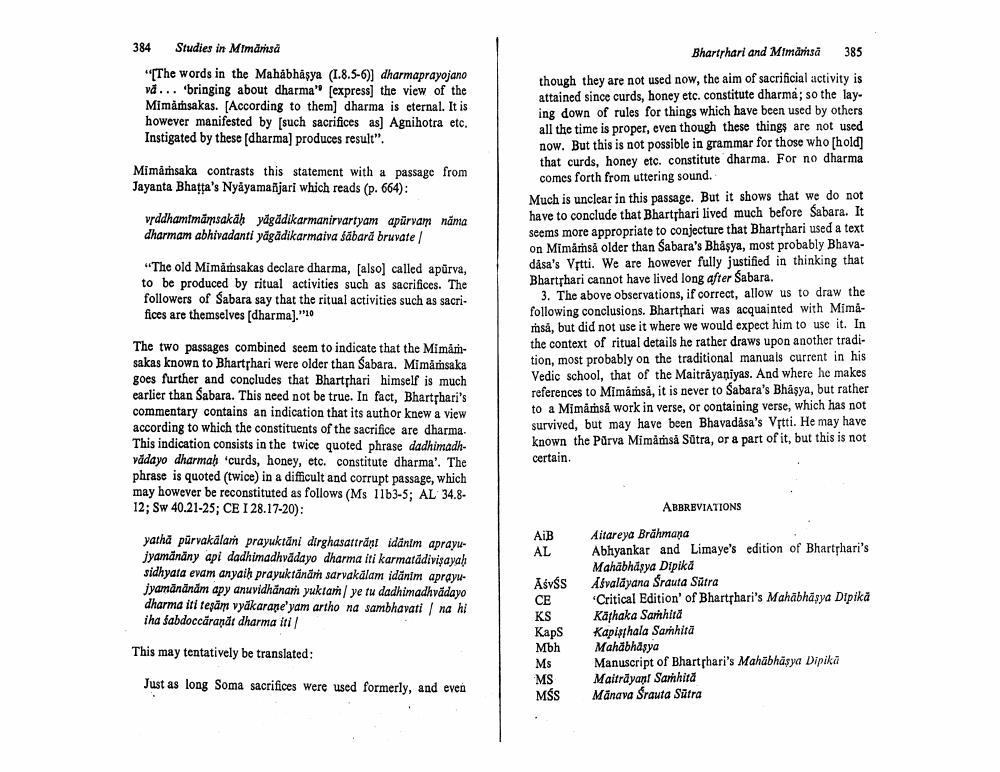________________
384 Studies in Mimämsä
"[The words in the Mahabhäşya (1.8.5-6)] dharmaprayojano va... bringing about dharma" [express] the view of the Mimamsakas. [According to them] dharma is eternal. It is however manifested by [such sacrifices as] Agnihotra etc. Instigated by these [dharma] produces result".
Mimämsaka contrasts this statement with a passage from Jayanta Bhatta's Nyayamañjari which reads (p. 664):
vrddhamtmämsakaḥ yägädikarmanirvartyam apurvam nama dharmam abhivadanti yägädikarmaiva śäbară bruvate/
"The old Mimamsakas declare dharma, [also] called apurva, to be produced by ritual activities such as sacrifices. The followers of Sabara say that the ritual activities such as sacrifices are themselves [dharma]."'10
The two passages combined seem to indicate that the Mimamsakas known to Bharthari were older than Sabara. Mimāṁsaka goes further and concludes that BhartŢhari himself is much earlier than Sabara. This need not be true. In fact, Bhartṛhari's commentary contains an indication that its author knew a view according to which the constituents of the sacrifice are dharma. This indication consists in the twice quoted phrase dadhimadhvadayo dharmaḥ 'curds, honey, etc. constitute dharma'. The phrase is quoted (twice) in a difficult and corrupt passage, which may however be reconstituted as follows (Ms 11b3-5; AL 34.812; Sw 40.21-25; CE I 28.17-20):
yatha pürvakälam prayuktäni dirghasattränt idänim aprayujyamänäny api dadhimadhvadayo dharma iti karmatädivişayaḥ sidhyata evam anyaiḥ prayuktänäṁ sarvakälam idānim aprayujyamänänām apy anuvidhanam yuktam / ye tu dadhimadhvädayo dharma iti teşäm vyäkarane'yam artho na sambhavati na hi iha sabdoccäranät dharma iti
This may tentatively be translated:
Just as long Soma sacrifices were used formerly, and even
Bhartrhari and Mimämsä
385
though they are not used now, the aim of sacrificial activity is attained since curds, honey etc. constitute dharma; so the laying down of rules for things which have been used by others all the time is proper, even though these things are not used now. But this is not possible in grammar for those who [hold] that curds, honey etc. constitute dharma. For no dharma comes forth from uttering sound.
Much is unclear in this passage. But it shows that we do not have to conclude that Bhartrhari lived much before Sabara. It seems more appropriate to conjecture that BhartŢhari used a text on Mimämsä older than Sabara's Bhasya, most probably Bhavadasa's Vrtti. We are however fully justified in thinking that Bharthari cannot have lived long after Sabara.
3. The above observations, if correct, allow us to draw the following conclusions. Bhartṛhari was acquainted with Mimåmså, but did not use it where we would expect him to use it. In the context of ritual details he rather draws upon another tradition, most probably on the traditional manuals current in his Vedic school, that of the Maitrayaniyas. And where he makes references to Mimamså, it is never to Sabara's Bhaşya, but rather to a Mimämsä work in verse, or containing verse, which has not survived, but may have been Bhavadasa's Vrtti. He may have known the Purva Mimämså Sütra, or a part of it, but this is not certain.
AiB AL
Asv$S CE
KS KapS Mbh
Ms
MS
MSS
ABBREVIATIONS
Aitareya Brähmaṇa
Abhyankar and Limaye's edition of Bhartrhari's Mahabhasya Dipika
Asvalayana Srauta Sutra
'Critical Edition' of Bhartrhari's Mahābhāṣya Dipika Käthaka Samhita
Kapisthala Samhita
Mahabhasya
Manuscript of Bharthari's Mahabhäṣya Dipikā
Maitrayant Samhitä Mänava Srauta Sutra




